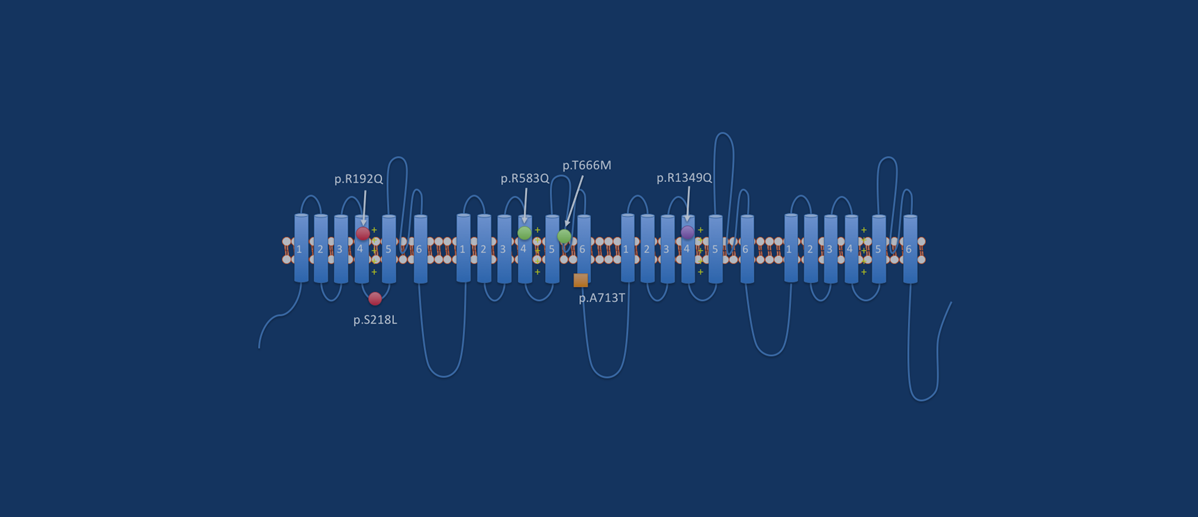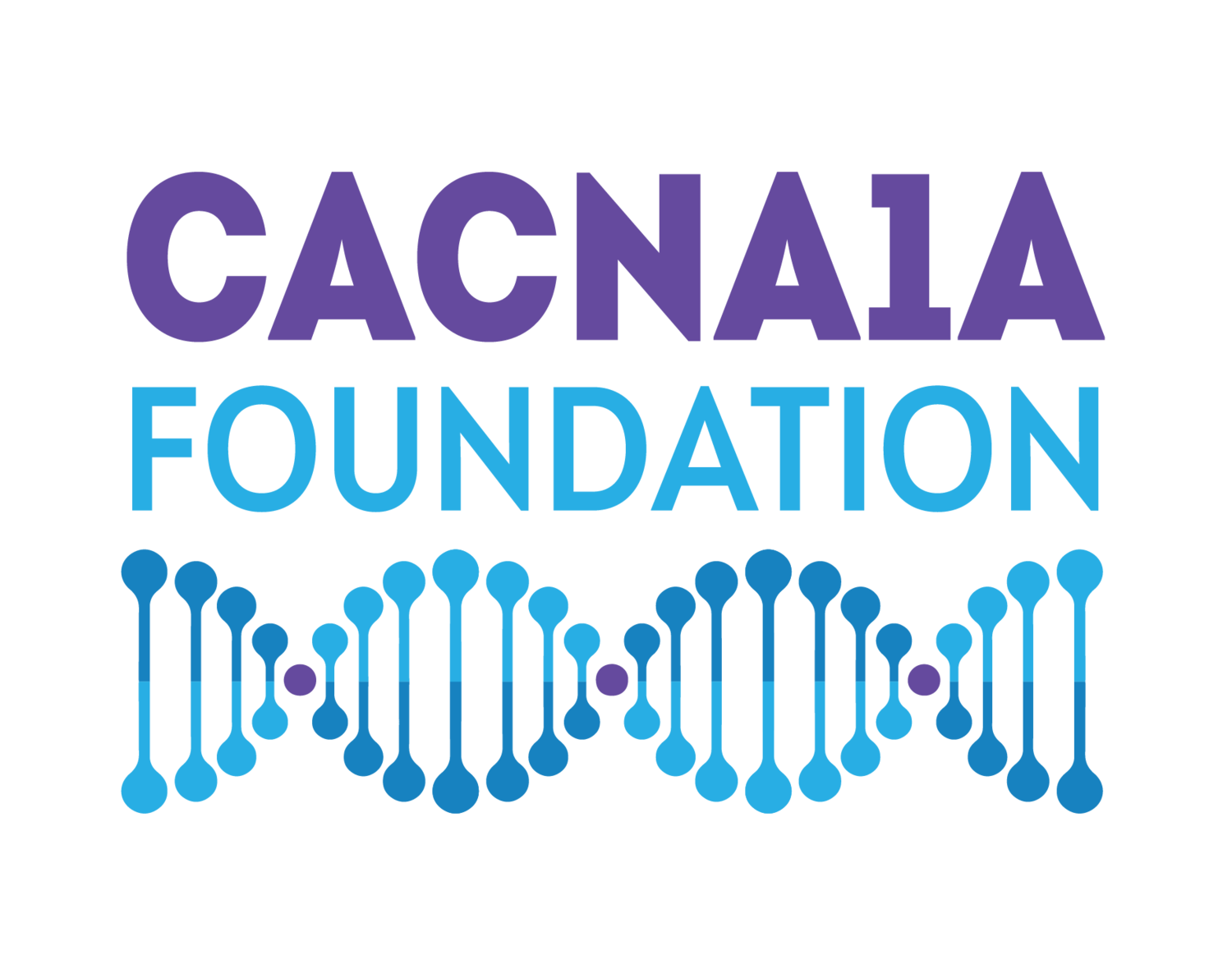
The Science of CACNA1A
CACNA1A Defined
Credit: Jacqueline Niu, Ph.D.
What is CACNA1A?
CACNA1A is a gene that plays a vital role in the communication between neurons in the brain. It is located on the short arm of chromosome 19 at position 13.13 and codes for the alpha-1A subunit of the P/Q-type voltage-gated calcium channel called Cav2.1. This subunit helps to form the pore (hole) of the channel through which ions flow. A change in the gene alters the function of the channel and affects the release of neurotransmitters.
CACNA1A variants are characterized as either Gain of Function (GOF) or Loss of Function (LOF).
In a Gain of Function variant, the calcium channel opens and stays open for a long time. As a result, calcium ion influx is increased, causing too much neuron excitability.
In a Loss of Function variant, the opposite occurs; there is improper channel opening, resulting in less calcium entering the cells and decreased neuronal firing.
Mutations in CACNA1A cause a number of neurological phenotypes (observable characteristics or traits). Channel function and its relationship to phenotype need to be better studied. However, research has shown that most LOF variants cause Episodic Ataxia Type 2 and GOF variants result in Hemiplegic Migraines. Studies have indicated clinical overlap, with features of both disorders being observed in patients. Congenital ataxia, cerebellar atrophy, epilepsy and intellectual disability are also seen in both Gain of Function and Loss of Function variants.
Spinocerebellar ataxia type 6 (SCA6) is an adult-onset neurodegenerative disorder caused by the expansion of a CAG repeat sequence of three DNA nucleotides at the end of the gene. This results in the degeneration of cerebellar Purkinje cells (important for motor coordination and balance). In non-affected individuals, the CAG segment is repeated less than 18 times. In those with SCA6, it is repeated 20-33 times.
References
Kordasiewicz HB, Thompson RM, Clark HB, Gomez CM. C-termini of P/Q-type Ca2+ channel alpha1A subunits translocate to nuclei and promote polyglutamine-mediated toxicity. Hum Mol Genet. 2006;15(10):1587-1599. doi:10.1093/hmg/ddl080
Luo, X., Rosenfeld, J. A., Yamamoto, S., Harel, T., Zuo, Z., Hall, M., Wierenga, K. J., Pastore, M. T., Bartholomew, D., Delgado, M. R., Rotenberg, J., Lewis, R. A., Emrick, L., Bacino, C. A., Eldomery, M. K., Coban Akdemir, Z., Xia, F., Yang, Y., Lalani, S. R., Lotze, T., … Members of the UDN (2017). Clinically severe CACNA1A alleles affect synaptic function and neurodegeneration differentially. PLoS genetics, 13(7), e1006905. https://doi.org/10.1371/journal.pgen.1006905
Ophoff, R. A., Terwindt, G. M., Vergouwe, M. N., van Eijk, R., Oefner, P. J., Hoffman, S. M. ., … Frants, R. R. (1996). Familial Hemiplegic Migraine and Episodic Ataxia Type-2 Are Caused by Mutations in the Ca2+ Channel Gene CACNL1A4. Cell, 87(3), 543–552.
Tian X, Gala U, Zhang Y, et al. A voltage-gated calcium channel regulates lysosomal fusion with endosomes and autophagosomes and is required for neuronal homeostasis. PLoS Biol. 2015;13(3):e1002103. Published 2015 Mar 26. doi:10.1371/journal.pbio.1002103.
What are CACNA1A-related disorders?
CACNA1A-related disorders are rare and lifelong conditions that affect the brain. People who have brain differences due to CACNA1A can have a wide range of symptoms or features, but they are united by the fact that their symptoms all are due to differences within the CACNA1A gene. These features can be broken down into a few main categories:
∙ Familial hemiplegic migraine (FHM1)/Sporadic hemiplegic migraine
∙ Ataxia – Episodic Ataxia Type 2 (EA2) and congenital ataxia
∙ Eye movement differences, such as nystagmus or paroxysmal tonic upgaze
∙ Epilepsy
∙ Neurodevelopmental differences
∙ Spinocerebellar ataxia Type 6 (SCA6)
These symptoms significantly impact the lives of the people who live with this disorder and their families. Current options for treating CACNA1A-related disorders are limited to managing and/or treating symptoms. There is no known cure for CACNA1A, but a genetic diagnosis provides the first steps for people to find an answer for their symptoms and connect with others affected by CACNA1A.
How is CACNA1A diagnosed?
CACNA1A-related disorders are diagnosed with a genetic test, as differences in other genes can also cause many of the same symptoms as CACNA1A variants. CACNA1A is one of about 20,000 genes in our body. Genes are the structures that provide the instructions for the proteins that allow our bodies to function. CACNA1A is a gene that is essential to brain function.
Our brains communicate by sending electrical signals between brain cells (neurons). If the CACNA1A gene does not work as it should, because of a pathogenic (disease-causing) variant (sometimes called a “mutation”), then the brain’s electrical signals are affected. These differences in electrical signals are what cause the symptoms that people with CACNA1A-related disorders experience.
Genetic tests allow us to zoom in on a gene and analyze it for variants that might affect the gene function. A person is diagnosed with a CACNA1A-related disorder when they show symptoms of the disorder and are found to have a genetic difference within CACNA1A.
Genetics of CACNA1A-related disorders
Everyone has two copies of the CACNA1A gene. Only one copy of CACNA1A needs to have a disease-causing variant for a person to have symptoms. Milder CACNA1A presentations (phenotypes) can be passed down through families in an autosomal dominant pattern. This means that each person with CACNA1A has a 50% chance of passing on the variant to each child that they have.
More severe phenotypes of CACNA1A tend to occur brand new, or de novo, in an affected person and not be present in either of that person's parents. Individuals with a de novo variant are the first individuals in their families to carry a disease-causing variant in CACNA1A. If a child is identified as the first person in their family with a CACNA1A-related disorder, the chance of this person having a future sibling that is affected is expected to be very low.
Different types of genetic variations within the CACNA1A gene can cause various symptoms. The spectrum of one’s possible symptoms cannot be fully predicted, however, from the individual variant in the CACNA1A gene. Importantly, individuals can carry disease-causing changes in CACNA1A that are passed down through a family, but not have any symptoms themselves.
Contributed by Sarah McKeown Ruggiero, MS, LCGC

